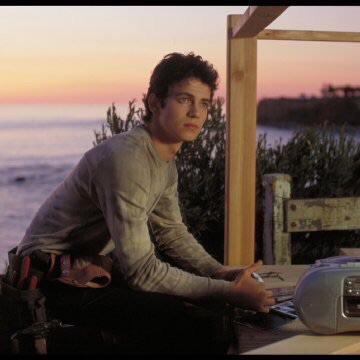we have it on video
The opening shot of Life as a House is a digital trick (one done much cleaner elsewhere, but not too bad for 2001)--the camera cranes down toward the shack, then through the window into the interior, focusing briefly on the model house that will be built later, then onto George in bed. The visual metaphor is simple: 1. we are being allowed into this man's life in an intimate fashion, 2. George is already being equated to that house and the shack; and 3. that house is inside the shack just as the idea of it, and the potential for its building is inside George. Additionally--and linked to #1 there--the window frame works as a stand-in for the frame of the camera, the frame of the movie screen, the frame of the TV as we watch the story begin. (That this window will soon not exist does not negate the metaphor because by then we're invested or explicitly disinterested.)
At the end of the film, George will also see the finished house (looking as small as that model) through the window of his hospital room. An echo of that opening shot.
The use of visual metaphor is important, though, just as--within the story--the garage door is important later (as George's and Sam's (Hayden Christensen) "home" opens up to Robin (Kristin Scott Thomas) and her sons, to Alyssa (Jena Malone), Josh (Ian Somerhalder) and... well, the whole crowd that is there helping in the third act). George doesn't own a computer, it's too soon for smart phones (made today, Sam's headphones would be replaced with a smartphone for him to stare at, I'm sure) and only once do we even see the television in the garage turned on--
(They're watching A Nightmare on Elm Street, which might actually be worth a discussion before this week is through... Actually, below, in this very entry.)
--as these people are not tied down to screens. But, there are internal screens that matter here. George's memory of (and a home video of) a specific moment in the ocean, holding Sam when he was a little boy--keeps coming back throughout the film. It's a moment that he remembers being happy. It's a moment captured on film and in his head.
I wrote about home videos before, when watching Home for the Holidays last November, when watching Christmas Vacation last December, when watching The Sixth Sense (sort of). Capturing a moment to try to hold onto to it as long as we can--that's normal, I suppose. The passage of time is not something we can stop, not something we can control. So, we have photos--we used to have physical photo albums full of them--and videos. In Christmas Vacation, the home videos are in the attic, which--again with the metaphor--is appropriate. Here, aside from one scene in which Robin films the construction and the scene at the end of the film in which she plays the older video for George in the hospital, the home video here comes out of nowhere. It's not on any screen. No character is watching it. It just shows up.
Like memory. Like thought.
It interrupts the flow of everyday life. It distracts from the present. It intrudes.

Character's are framed in windows, by shower doors, car windshields. Just as our lives are framed by the homes we live in (to be a little cheesy about it).
Actually, it's okay to be cheesy about it with this film. The home video, the visual framing, even the inexplicable (seriously, we would have seen that hospital and the other tall buildings near it in earlier shots if it was that close) hospital view with those Christmas lights--it's all one step separated from the reality of the film, and an extra step removed from our reality. It's almost like a fairy tale. In fact, George's line at the end of the film--"if you were a house, this is where you would want to be built. On rock, facing the sea, listening"--evokes the Matthew 7:24-27:
Therefore whosoever heareth these sayings of mine, and doeth them, I will liken him unto a wise man, which built his house upon a rock:And the rain descended, and the floods came, and the winds blew, and beat upon that house; and it fell not: for it was founded upon a rock.
And every one that heareth these sayings of mine, and doeth them not, shall be likened unto a ffoolish man, which built his house upon the sand:
And the rain descended, and the floods came, and the winds blew, and beat upon that house; and it fell: and great was the fall of it.
A story. A myth. A fairy tale that teaches us a lessen, just like Life as a House. Realism isn't the point. The nurse who touches George early in the film--that scene is a little awkward unless you think of the story as a story. She is a supporting character in the myth who might have her own following separate from George or Sam or Robin. She is the kind nurse who offered human contact. Alyssa's bit, coming to George and kissing him--that is also a little awkward if you want realism. But, as myth, she is another offering of human contact, not just for him but moreso for Sam.
The movie works best as a story, an allegory. The title itself is a simile. That's why it makes sense that they're watching A Nightmare on Elm Street the one time they have the television turned on. It's a movie about dreams and--SPOILERS--it's a movie that is a dream. This movie works better with a little bit of dream logic. It relies on coincidence, it relies on Pairing the Spares and it relies on characters saying awkward things occasionally when a script rewrite may have changed that.
And, it presumes that everyone is broken... which is really a topic for another day.
Comments
Post a Comment